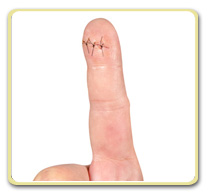It’s tricky to know when a cut needs stitches or some other means of closure. Many minor lacerations will heal by themselves, but some will heal faster and with less likelihood of complications when one of the methods of primary wound closure are used. There are several ways of closing a wound such as:
- Traditional stitches (sutures). Suturing is the most common method used for wound closure. Much like repairing a tear in a shirt, suturing involves the use of sterile needles and suture material (usually made from silk or nylon) to sew the wound edges together.
- Skin staples. Stapling is most commonly used for deeper wounds that have straight, sharp edges. Wound stapling is particularly useful in closing wounds in the scalp and is often employed in closing surgical wounds.
- Adhesive strips (butterfly, Steri-Strip™, etc.) Strips are effective for small cuts and wounds that are not under tension. A laceration on the forearm, for example, would have less tension on the wound edges than one over a knuckle that is stressed each time the finger is moved. A major advantage of adhesive strips is that application is essentially painless.
- Skin adhesive (skin glue). Similar to “Super Glue”, a skin adhesive such as Dermabond (2-octylcyanoacrylate) is best suited for small, superficial lacerations. The adhesive forms a bond over the wound edges allowing healing to occur below.
In evaluating a wound, the medical professional must make an assessment of the method of wound closure that is most appropriate. Reasons to seek a medical opinion on the need for stitches or some other method of primary wound closure include:
- Deep wounds that extend beneath the dermis of the skin into underlying fat or muscle layers.
- Wounds that have jagged edges or that gape open.
- Wounds located over a joint, such as a knuckle or the knee, that would be repeatedly stressed by movement of the joint.
- Wounds on the face, lips, eyelids, or other areas of the body where a cosmetic result is important.
- Wounds longer than ¾ in or that are deeper than a ¼ inch.
- Wounds affecting the genitalia.
- Wounds that bleed profusely or continue to bleed despite application of pressure to the wound.
- A wound in which there is a possibility that a foreign object, such as a piece of glass, remains within the wound.
- Wounds that result from an animal or human bite. In addition to stitches, these may require a tetanus booster or antibiotics.
- Dirty or contaminated wounds that require thorough cleaning before closure options are considered.
Primary wound closure with one of the methods described above should generally be accomplished as soon as possible following the injury. The risk of the wound becoming infected increases the longer a wound remains open. In fact, waiting too long to seek medical attention following a laceration may require that the wound remain open so that adequate cleaning and treatment with antibiotics can be instituted prior to the closure.
Sources for article:
Does Your Cut Need Stitches? Find Out How to Tell from the Cleveland Clinic
Cuts: When Stitches Are Needed from WebMD
If you have any questions about wounds, please log into your account and send
us your question. We are here to help.

